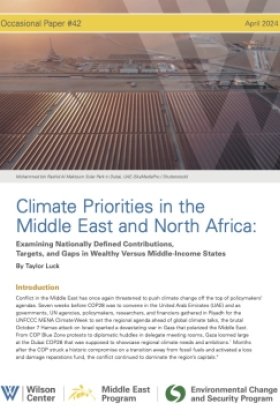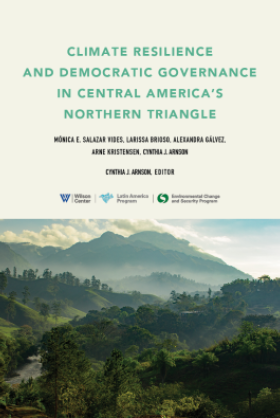<b>A New Vigilance: Identifying and Reducing the Risks of Environmental Terrorism</b>
Featuring Elizabeth Chalecki, Research Affiliate, Pacific Institute for Studies in Development, Environment, and Security
Overview
By Robert Lalasz
Could rivers, forests, and farm fields become weapons of terrorism? The Pacific Institute's Elizabeth Chalecki discussed with a Wilson Center audience of military, intelligence, and diplomatic experts how terrorists could target or even use the environment and natural resources to wreak much more extensive destruction than conventional terrorism.
Chalecki also argued that terrorists are more likely to launch such attacks than use weapons of mass destruction. "Resources are easy to access and vulnerable," she said. "Taking out a dam or poisoning a water supply would have far more consequences than a suicide bomber."
What is Environmental Terrorism?
Chalecki defined environmental terrorism as the unlawful use of force or violence against environmental resources so as to deprive populations of their benefits and destroy other property. Particularly vulnerable are resources such as water, agriculture, mineral and petroleum, and wildlife.
Chaelcki said that, while the FBI is working on hardening water infrastructure against attacks, that infrastructure is still easily accessible and a potentially potent way to transport poison or disease-causing agents.
"The difficulty of a far-reaching attack on a major city's water supply is now merely a technological hurdle," she said. "I have no doubt that this will happen."
Attacks on agriculture or forests, Chalecki said, could have far reaching consequences for the world economy and strategically important locations, such as with the Chilean grape cyanide scare of several years ago or the 2001 Bandolier National Forest fire in New Mexico that threatened the United States National Laboratory in Los Alamos. The recent foot-and-mouth outbreak in the United Kingdom, which shook that country's government to the core, also demonstrates the possible destabilizing effects of terrorist attacks on food supplies.
Terrorists could also target petroleum infrastructure such as the Trans Alaska Pipeline, where a hunter's errant shot caused $3 million in lost revenue and cleanup costs. And Chalecki argued that wildlife and ecosystems are also vulnerable to a range of destructive actions, ranging from the recent murder of Galapagos turtles by disgruntled Ecuadorian fishers to the vast oil fires set by Iraqi forces as they retreated from Kuwait in 1991.
Recommendations
Chalecki recommended that, in the face of these threats, the United States allocate more funds to environmental-resource and infrastructure protection. But she also advocated that the U.S. government broaden its focus to incorporate these threats in anti-terrorism efforts.
"Of the eight infrastructures that the FBI Infrastructure Protection Center has identified as vulnerable," Chalecki said, "water was the only one environmentally related." But she expressed skepticism that the Bush Administration would respond proactively to environmental terrorism, and she called on citizens to help diversify our resource bases (particularly away from petroleum) and to get involved in monitoring resources for unusual events that could signal terrorism.
Additional Links
Elizabeth Chalecki: A New Vigilance: Identifying and Reducing the Risks of Environmental Terrorism
Hosted By

Environmental Change and Security Program
The Environmental Change and Security Program (ECSP) explores the connections between environmental change, health, and population dynamics and their links to conflict, human insecurity, and foreign policy. Read more
Thank you for your interest in this event. Please send any feedback or questions to our Events staff.








